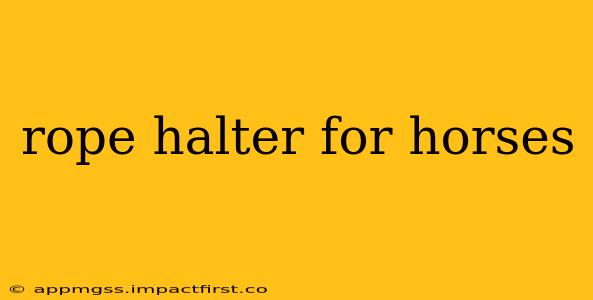Rope halters have become increasingly popular among horse owners for their versatility and effectiveness in training and handling. Unlike traditional leather or nylon halters, rope halters offer a unique combination of gentle pressure and control, making them a valuable tool for both experienced and novice horse handlers. This comprehensive guide explores the benefits, different types, proper fitting, and safe usage of rope halters for horses.
What are the Benefits of Using a Rope Halter for Horses?
Rope halters offer several advantages over traditional halters:
- Increased Communication: The soft, yet firm pressure exerted by a rope halter allows for more subtle communication with the horse. This helps the horse understand and respond to cues more readily.
- Gentle Control: While providing control, rope halters are designed to distribute pressure more evenly across the horse's face, minimizing the risk of injury compared to harsher methods.
- Versatility: Rope halters are suitable for various disciplines, from groundwork and trail riding to light training and even showing (in some contexts).
- Durability: Made from strong, durable materials, rope halters can withstand regular use and are generally more resistant to wear and tear than leather or nylon halters.
- Affordability: Rope halters are often more cost-effective than other halter types, making them an accessible option for horse owners on a budget.
What are the Different Types of Rope Halters?
While the basic design remains similar, rope halters come in a variety of styles and materials:
- Traditional Rope Halters: These are the most common type, usually made from nylon or polyproplyene rope, featuring a simple knot design for the crownpiece and noseband.
- Braided Rope Halters: These offer a softer feel and often a more polished appearance.
- Double-Ply Rope Halters: Constructed with two layers of rope, these provide increased durability and longevity.
- Specialty Rope Halters: Some rope halters incorporate additional features, such as padded nosebands or specific knot configurations designed for particular training methods.
How Do I Properly Fit a Rope Halter on My Horse?
Proper fitting is crucial for both the horse's comfort and safety. An improperly fitted halter can cause discomfort, interfere with the horse's vision, or even lead to injury.
- Crown Piece: The crown piece should sit comfortably high on the poll (the highest point of the horse's head), without pressing too tightly. You should be able to fit two fingers comfortably between the crown piece and the horse's poll.
- Noseband: The noseband should be adjusted to sit comfortably below the cheekbones, allowing for about two fingers between the noseband and the horse's nose. Avoid adjusting it too tight, as this can cause discomfort and potentially damage the nasal passages.
- Throatlatch: The throatlatch should be adjusted to allow for two fingers to slide underneath comfortably. It should be tight enough to prevent the halter from sliding over the horse's head, but not so tight as to restrict breathing or swallowing.
Are Rope Halters Cruel?
Many people question the humane aspects of rope halters. The key is to understand and apply the correct pressure. A properly fitted and used rope halter can be a humane and effective training tool, providing gentle, yet firm guidance. However, misuse can cause pain and discomfort. Improper fitting or excessive pressure can be damaging. Always prioritize the horse's well-being and use a rope halter responsibly and ethically. Learning from experienced horse handlers or attending training workshops is highly beneficial.
What are the Best Rope Halters for Young Horses?
Young horses often require gentler handling. A rope halter with a padded noseband can be a more comfortable option for them. The lighter weight of a rope halter also makes it less cumbersome for a young horse to get used to the sensation of wearing a halter. However, proper fitting and gentle handling remain paramount regardless of age.
How Do I Clean a Rope Halter?
Rope halters are relatively easy to clean. Most can be rinsed with water and a mild detergent, then allowed to air dry. Avoid using harsh chemicals or abrasive cleaners, as these can damage the rope.
What Size Rope Halter Do I Need?
Rope halters are sized based on the horse's head size. Measure your horse's head circumference from around the base of the ears, over the poll, and down to the point where the noseband will sit. This measurement will guide you in selecting the appropriate size.
This guide provides a comprehensive overview of rope halters for horses. Always prioritize responsible use and the horse's well-being. Remember that proper fitting and training are essential for safe and effective handling.
